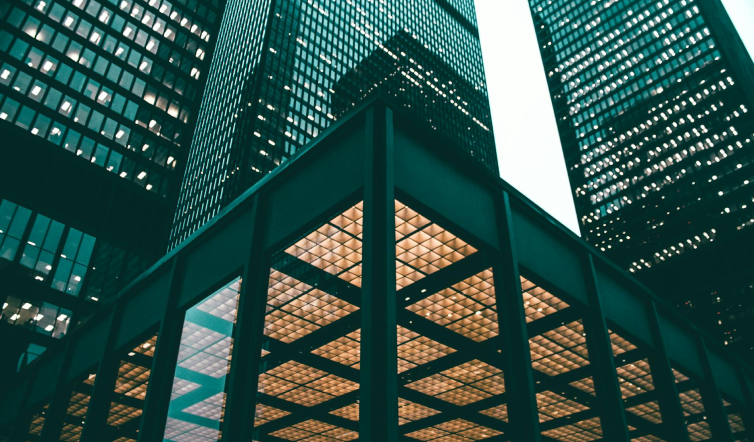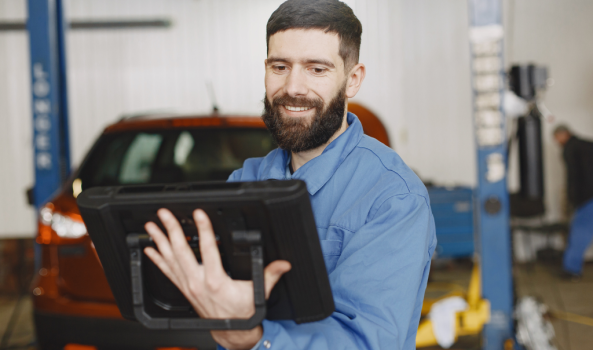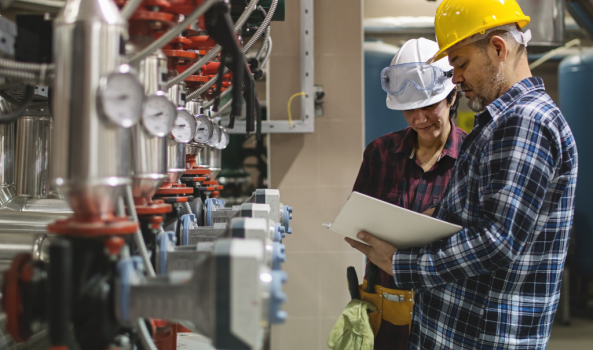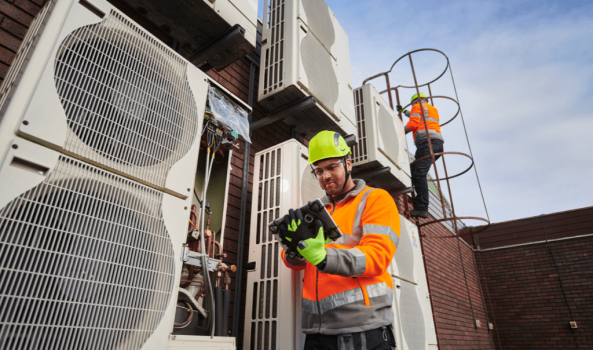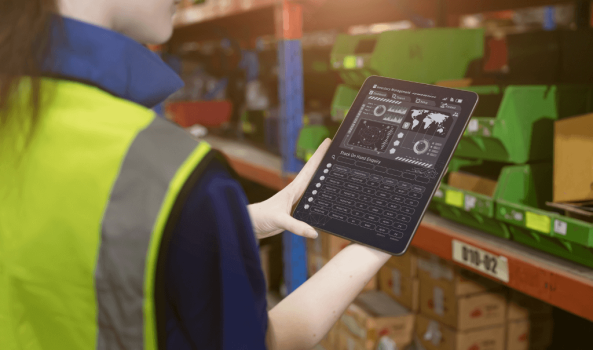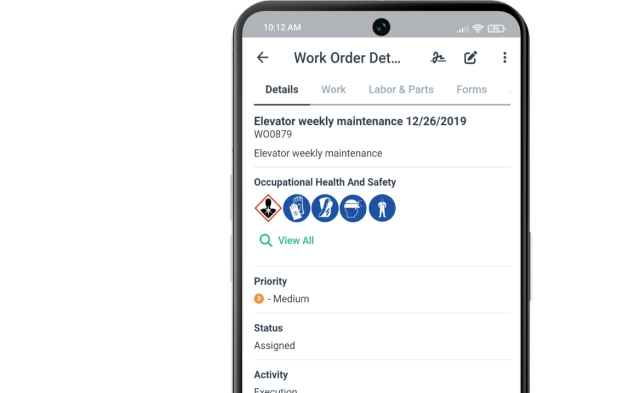Get a Free WorkTrek Demo
Let's show you how WorkTrek can help you optimize your maintenance operation.
Try for freeAfter ten years working with property management companies, we’ve learned that commercial property maintenance isn’t just about keeping buildings pretty. It’s the difference between a thriving investment and a money pit that keeps you awake at night.
The question “why is commercial property maintenance important” comes up constantly in our industry, and honestly, the answer goes way deeper than most people realize.

Commercial property maintenance encompasses everything from daily janitorial services to major system overhauls, and getting it right can make or break your investment.
What do property managers deal with?
When property managers discuss maintenance, they are not just talking about someone sweeping the floors. Managing a property requires a comprehensive maintenance plan that should cover all building components that keep your commercial property running smoothly.
As a seasoned property manager, you already know that proper maintenance affects everything from tenant retention to market value.

Commercial buildings that consistently perform well all have one thing in common: Owners and maintenance managers who understand the importance of preventative maintenance.
Your property maintenance plan needs to address:
- Daily maintenance tasks like cleaning and basic monitoring
- Preventive maintenance tasks, such as regular inspections of major systems
- Emergency repairs when building components fail unexpectedly
- Major repairs and system replacements that protect long-term value
Different types of commercial buildings have their own unique challenges.
Office properties focus on accessible and comfortable environments with quality climate control and energy-efficient lighting.
Retail spaces need attractive exteriors and safe areas for tenants and visitors.
Industrial facilities prioritize the functionality of their equipment, easy access to loading docks, and compliance with local building codes.
How to increase property values
There are various tactics that experienced facility managers use to separate successful properties from struggling ones.
A lot of these tactics ensure that your property can retain and increase its value.
Your Commercial Property Remains Valuable
We’ve watched identical buildings in the same market follow completely different paths based solely on their maintenance approach.
For example, a well-maintained property typically sees 10-15% higher market value compared to neglected competitors. That’s not just theory, that’s real money in your pocket.
The proactive approach always wins.
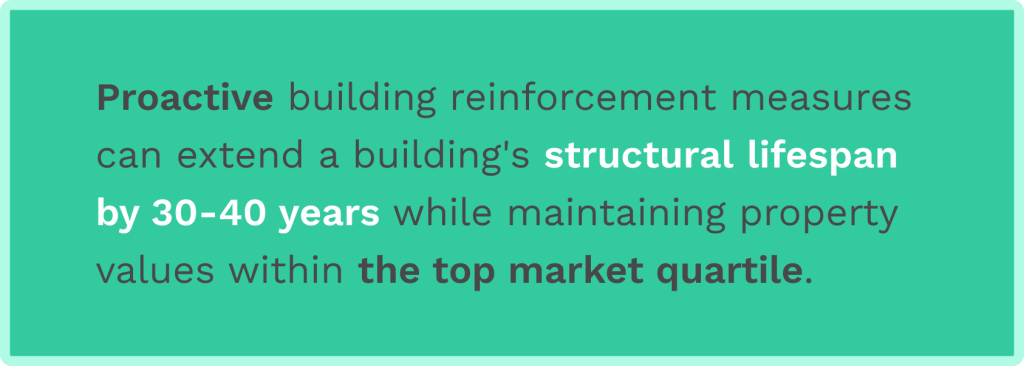
Implementing a preventive maintenance plan will help improve your equipment’s lifespan and keep your building in top shape.
For example, a well maintained HVAC systems can last 20-25 years instead of 15-20 years with neglect.
When you’re talking about $100,000+ replacement costs, that extra lifespan represents serious cost savings.
Tenant Satisfaction Drives Everything
As a building owner, you already know that happy tenants mean stable cash flow.
When your building is clean and inviting, has properly working systems, and issues get resolved quickly, tenant retention soars.
Property management becomes streamlined when you’re not constantly dealing with complaints and putting out fires.
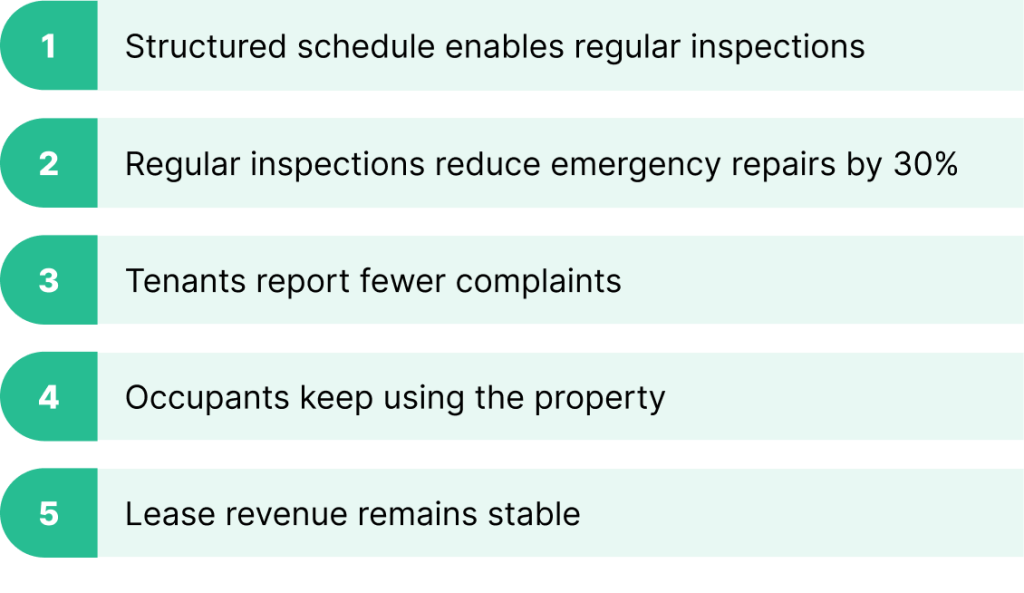
Most commercial leases require a response to maintenance requests within 24-48 hours. Properties that consistently meet these deadlines through efficient maintenance efforts see dramatically lower vacancy rates.
Tenant satisfaction also depends on factors such as energy efficiency standards compliance, proper security systems operation, and maintaining comfortable environments.
When tenants and visitors experience consistent quality, it reflects positively on their businesses too.
The Math on Cost Savings
This might sound backwards, but spending money on ongoing maintenance actually helps you save money long-term.
Industry data consistently shows that every dollar invested in preventive maintenance programs saves $3-5 in emergency repairs.
Consider these real numbers from my experience:
- Regular HVAC filter changes: $30-60 per visit
- Emergency system replacement: $18,000-30,000
- Routine plumbing inspections: $200-400 quarterly
- Emergency water damage repairs: $15,000-50,000+
Predictive Maintenance for Buildings

Predictive maintenance has started to change property maintenance. Smart sensors embedded in variety of equipment types such as HVAC systems, Chillers and various pumps can detect minor issues that most humans might miss.
This data can then be sent to maintenance teams for further testing and validation.
Legal Requirements
Commercial property managers deal with various regulatory issues.
Fire safety systems, local building codes, ADA compliance, —these aren’t suggestions, they’re legal requirements that can shut down your building if ignored.
Performing regular inspections helps ensure compliance with safety standards. You don’t want to get on a building inspector’s bad side by missing simple compliance requirements.
Fire safety systems need constant attention. Sprinkler systems, emergency lighting, and evacuation routes must be tested regularly.
Ignoring compliance and legal maintenance can lead to substantial liability risk.
Poor maintenance can lead to accidents involving tenants and visitors, resulting in expensive lawsuits. Insurance companies routinely deny claims when they determine incidents resulted from negligent maintenance practices.
Create Your Maintenance Strategy
Any successful property management starts with planning. The first step in the process is to create a commercial property maintenance checklist that covers every critical system.
Developing Your Comprehensive Maintenance Plan — Learn more about the importance of maintainability when creating effective maintenance strategies.
It is nearly impossible to track all of your maintenance needs without good documentation. A typical plan should specify precisely what needs attention and when.
Some examples include:
- HVAC systems: Monthly filter changes, quarterly inspections
- Electrical systems: Quarterly safety checks, annual panel evaluations
- Plumbing systems: Bi-annual comprehensive assessments
- Roofing systems: Annual structural integrity inspections
- Security systems: Monthly testing, quarterly updates
Don’t forget about sustainable practices either.
A typical property maintenance program now include recycling programs and energy-efficient upgrades that can reduce overall operational costs.
Creating Your Regular Maintenance Schedule
Different building components need attention at different intervals. Facility managers who get this right create schedules that prevent problems before they start.
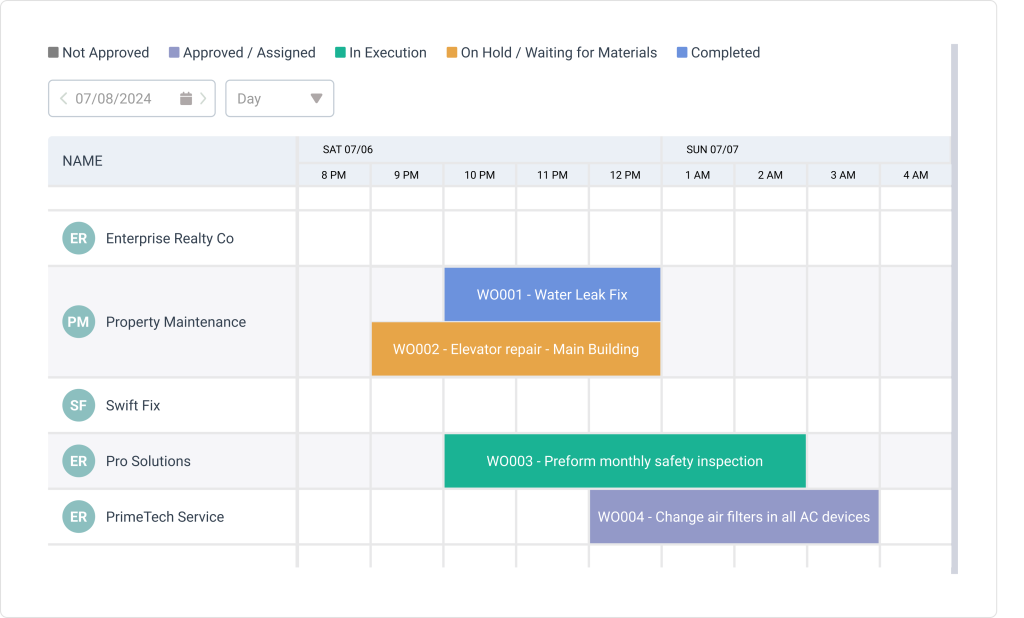
Routine inspections should cover:
- Daily: Basic building operations, janitorial services quality
- Weekly: Common areas, exterior inspections for obvious issues
- Monthly: Major systems performance, pest control effectiveness
- Quarterly: Safety systems, detailed building components assessment
- Annually: Comprehensive evaluations, irrigation systems, major equipment
The key is to stay consistent.
A regular commercial property maintenance program works because it catches minor repairs before they become major headaches.
Budget Planning That Works
Setting realistic budgets doesn’t have to be a chore. A good rule of thumb for the industry is to plan to spend 1-3% of your property’s value annually on maintenance costs.
It is helpful to create separate budget categories to help with tracking:
- Routine preventive maintenance tasks
- Emergency response plans and repairs
- Major systems replacements and upgrades
- Compliance-related safety inspections
Also, consider tracking spending by system type to identify patterns.
For instance, if your HVAC costs consistently exceed projections, it may be time to consider replacement rather than continuous repairs.
Managing Daily Operations
Strategic planning is clearly important, but a successful facility manager knows that managing and executing daily tasks is equally important.
Cleaning and Professional Appearance
As the famous saying goes, “You never get a second chance to make a good first impression”.
Prospective tenants and visitors can quickly develop a negative view of your property if it is not well-maintained.
Maintaining professional janitorial services maintains clean, healthy environments that support tenant and visitor satisfaction.
A typical commercial property maintenance services typically include daily cleaning, weekly deep cleaning, and monthly specialized tasks like carpet shampooing and window cleaning.
Critical Building Systems
For most facilities, major systems include HVAC, electrical, and plumbing. All of these systems require specialized attention from qualified professionals.
If you neglect these building components, then there is a chance for a much costlier repair.
Don’t forget that energy-efficient lighting upgrades deserve special mention.
LED systems paired with automated controls and motion detectors significantly reduce operational costs while improving tenant comfort.
The initial investment typically pays for itself within 2-3 years through energy savings.
Managing Problems When They Arise
Maintenance professionals know that despite the best preventive maintenance program, emergencies will happen.
The challenge is how quickly and effectively you respond. That is what makes the difference between a minor inconvenience and a major disaster.
Emergency Response Plans
Define and establish protocols for handling urgent maintenance issues.
Work with your contractors and establish response time requirements.
Emergency priorities should focus on:
- Life safety issues (gas leaks, electrical hazards)
- Property damage prevention (water leaks, roof failures)
- Business operation continuity (HVAC failures, power outages)
- Security system malfunctions
Routine Maintenance Issues
There are day-to-day maintenance requests that also need to be addressed.
Computerized Maintenance Management Systems like WorkTrek can simplify request tracking from submission to completion.
Minor repairs like fixture replacements, door adjustments, and basic plumbing fixes should be handled quickly to maintain tenant satisfaction.
How Technology Can Transform Your Maintenance Game
Implementing the right CMMS. Specifically, WorkTrek CMMS has revolutionized how property managers handle everything from routine inspections to emergency response plans.
Before we dive into the long-term strategies, let us discuss a CMMS can streamline every aspect of commerical property maintenance.
If you’re still managing maintenance with spreadsheets and sticky notes, you’re making your job harder than it needs to be.
Streamlining Your Comprehensive Maintenance Schedule
Here’s what sets workTrek CMMS part: it takes all those maintenance tasks we’ve been talking about and puts them into one organized system.
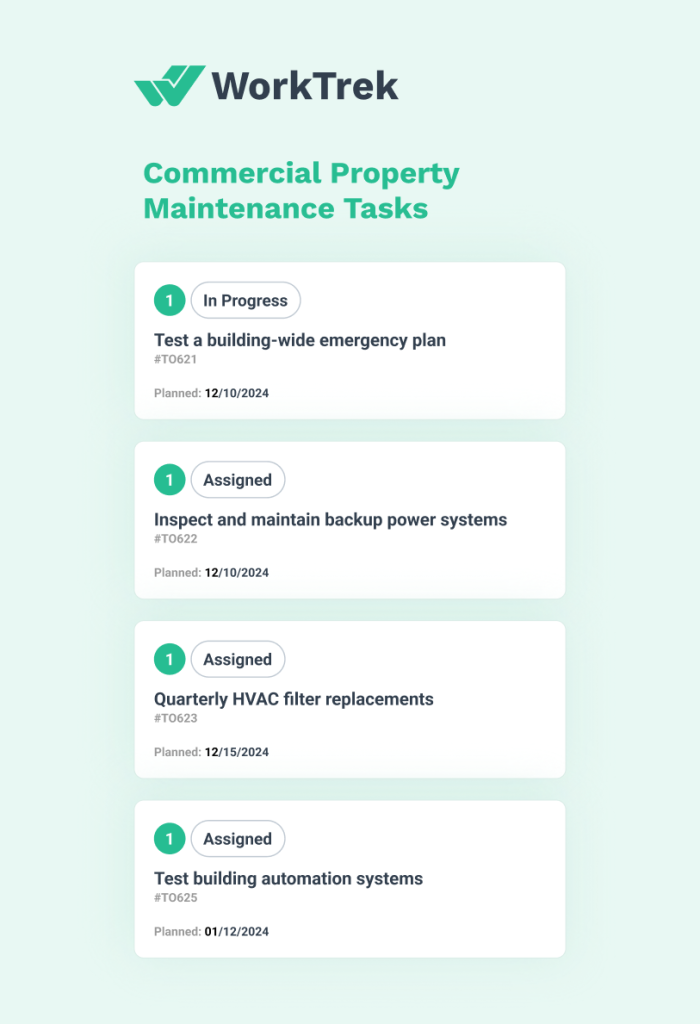
You can automate your comprehensive maintenance schedule, so you’re not constantly wondering if someone remembered to check the HVAC filters.
The system sends automatic reminders for preventive maintenance tasks, tracks work orders from start to finish, and maintains detailed records of every building component.
When a tenant calls about a maintenance issue, you can instantly see the history of that equipment, when it was last serviced, and what parts might be needed.
For facility managers and property owners juggling multiple commercial buildings, this kind of organization is invaluable.
Instead of trying to remember which property needs what attention when, the system manages your entire maintenance schedule across all locations and maintenance teams.
Boosting Tenant Satisfaction Through Better Response
One of my property management company clients saw their tenant satisfaction scores jump 40% after implementing workTrek CMMS.
Here’s why: tenants can submit maintenance requests directly through the system. What is more impressive is that they get real-time updates on the status of their requests.
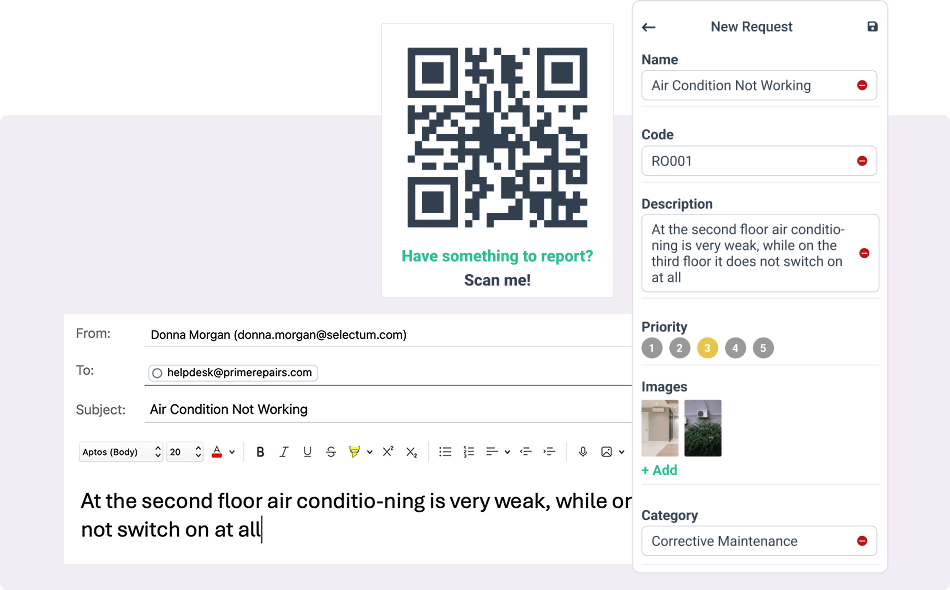
No more “I’ll look into it” responses that leave tenants wondering if you forgot about their problem.
The system tracks response times, ensures nothing falls through the cracks, and provides transparency that tenants appreciate.
WorkTrek’s mobile app means your maintenance team can update work orders in real-time, take photos of issues, and communicate directly with both property managers and tenants.
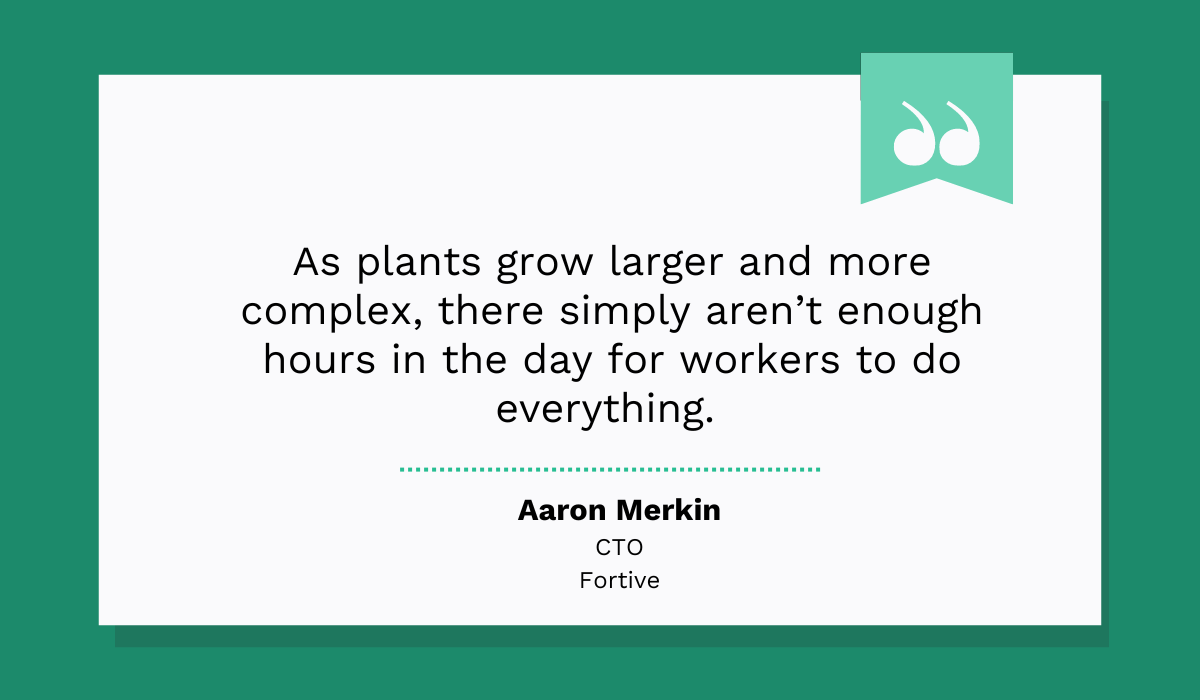
When someone reports a plumbing problem, you can track the entire process from initial report to final resolution.
Making Cost Savings Visible
Remember those cost savings we talked about from preventive maintenance? WorkTrek CMMS actually helps you track and prove those savings.
The system maintains detailed cost records for every repair, allowing you to compare preventive maintenance costs against emergency repair expenses.
We’ve seen property managers use this data to justify maintenance budgets to ownership groups.
When you can show property owners that spending $500 on preventive HVAC maintenance prevented a $15,000 emergency replacement, those budget conversations become much easier.

The system also helps identify patterns.
If certain building components are requiring frequent minor repairs, the data might indicate it’s time for replacement rather than continued patch jobs.
Ensuring Compliance and Safety
For those safety inspections and compliance requirements we discussed, WorkTrek CMMS maintains detailed audit trails.
When inspectors ask for documentation of fire safety system testing or elevator maintenance records, all records are organized and easily accessible.
The system can easily be configured to ensure compliance with local building codes by automatically scheduling required inspections and maintaining certification records.
For property managers dealing with multiple jurisdictions, this standardization is incredibly valuable.
Supporting Your Maintenance Team
Your maintenance staff will thank you for implementing a proper CMMS.
Instead of juggling paperwork, orders, and trying to remember equipment specifications, they have instant access to manufacturer information, maintenance histories, and step-by-step procedures right on their mobile devices.
The system also supports predictive maintenance by tracking equipment performance data over time.
This helps identify when major systems might need attention before they fail, supporting that proactive approach that saves money and prevents tenant disruptions.
Long-Term Success Strategies
The most successful commercial property managers think and plan beyond just simple fixes.
They invest in technology and improvements that will optimize their operations.
Smart Technology Integration
There are a number of smart technology systems that help provide real-time monitoring of major systems’ performance.

Some smart technology examples include:
- HVAC sensors for temperature and air quality monitoring
- Water leak detection systems
- Electrical monitoring for power consumption tracking
- Occupancy sensors for usage optimization
- Vibration sensors for mechanical equipment monitoring
Strategic Improvement Planning
Plan major upgrades during low-occupancy periods to minimize tenant disruption.
A comprehensive maintenance plan should include 5-year capital improvement schedules that address system replacements before failures occur.
Consider sustainable practices in all improvement decisions.
Energy-efficient equipment, water-saving fixtures, and environmentally friendly materials appeal to modern tenants while reducing operational costs.
Conclusion
Commercial property maintenance isn’t glamorous work, but it’s essential for long-term success.
Properties that conduct inspections regularly, maintain comprehensive maintenance schedules, and address maintenance issues promptly consistently outperform their neglected competitors.
Start with a solid property maintenance plan, budget realistically for both routine and emergency needs, and don’t cut corners on professional services. Implement a CMMS system like WorkTrek to help optimize your operations.



